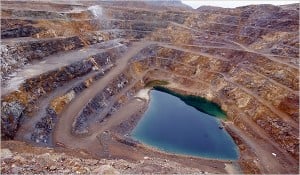 September was supposed to be the month in which operations began at a rare earth processing facility located in Kuantan, Malaysia, a fast-growing port city situated along the South China Sea. The project, awarded to the Australian-based Lynas Corporation, was originally envisaged as a lofty effort at breaking the Chinese monopoly of the production of rare earth metals. However, expectations quickly grew after it was reported that the Kuantan plant, upon completion, would become the largest rare earth mining center in the world. Malaysia, offering business-friendly tax incentives and large swaths of purchasable land, seemed to be an ideal place to base the project. But the anticipated commencement of the plant is uncertain now because of a grassroots campaign spearheaded by the local population of Kuantan over the ecological and environmental consequences of the project. Moreover, concerns have been raised by engineers during construction about the structural integrity of the plant.
September was supposed to be the month in which operations began at a rare earth processing facility located in Kuantan, Malaysia, a fast-growing port city situated along the South China Sea. The project, awarded to the Australian-based Lynas Corporation, was originally envisaged as a lofty effort at breaking the Chinese monopoly of the production of rare earth metals. However, expectations quickly grew after it was reported that the Kuantan plant, upon completion, would become the largest rare earth mining center in the world. Malaysia, offering business-friendly tax incentives and large swaths of purchasable land, seemed to be an ideal place to base the project. But the anticipated commencement of the plant is uncertain now because of a grassroots campaign spearheaded by the local population of Kuantan over the ecological and environmental consequences of the project. Moreover, concerns have been raised by engineers during construction about the structural integrity of the plant.
Rare earth metals are essential in many of the components of technological appliances. As The Wall Street Journal reported in July:
The 17 elements are favored for a host of niche applications because of their unusual characteristics. Magnets made with the rare-earth minerals neodymium and praseodymium are uniquely strong, making them valuable components in wind turbines and computer hard drives. Rare-earth phosphors such as europium and yttrium are in demand to tweak the color of compact fluorescent light bulbs and LED displays.
However, the toxicity of the byproducts of rare earth mining have rendered the practice a casus belli for environmental activists, protesters, and the local inhabitants in Kuantan who are on the front lines of this conflict. One of the byproducts in the process of refining rare earth materials from monazite sands is thorium (thorium-232), a radioactive chemical element that can be used in the production of nuclear energy.
The flip side of the debate is that rare earth metals are similarly essential in the production of new, green technologies. Everything from hybrid cars, to wind turbines, to smart light bulbs are manufactured using various rare earth metals. Do the amount of radioactive waste and the dangerous levels of pollution that the processing of rare earth materials emits outweigh the cost-benefit of its positive side from both an industrial and technological perspective? This is the conundrum which the actors involved in this drama are being forced to confront.
An organization called “Save Malaysia – Stop Lynas” is at the forefront of the effort to prevent the opening of the plant. Utilizing blogs and social media, the group has achieved some notoriety in the Malaysian press and in the online blogosphere; they were even able to secure a meeting with Lynas CEO Nick Curtis, the details of which have not been released. Such grassroots, indigenous pressure on globalized companies have had moderate success in the past, such as the Cochabamba protests in Bolivia against water giant Bechtel in the early 2000s. The lesson being that national governments, the international community, and multinational corporations should never underestimate the will of an indigenous group to protect the resources on their land.
Ninety percent of the world’s rare earth mining is done is China, where environmental regulation is virtually nonexistent. The domination which Beijing asserts in this area has given it the type of control over the supply of rare earth metals that is akin to OPEC’s position in the oil market. From July 2010 to February 2011, the price of rare earth metals increased nine fold. Because China controls a substantial majority of the world’s supply, it can unilaterally affect demand prices by cutting export quotas and raising taxes on importers. In such a respect, Lynas’ attempt to break this monopoly can be appropriately contextualized.
A common theme of the international relations theoretical framework of realism is charting the behavior of major actors. The smaller, weaker and voiceless actors are often left on the sidelines. It will be interesting to observe if poor, local farmers in Kuantan will be able to affect real change and prevent Lynas from setting up shop. Conventional wisdom suggests that corporations, seeing huge profits and bringing with them much needed foreign direct investment, usually end up on the winning side. But when the land is irreversibly degraded, the water unfit for human or livestock consumption, and when the crops can no longer grow, it will be too late for the Malaysian government to reverse their decision.